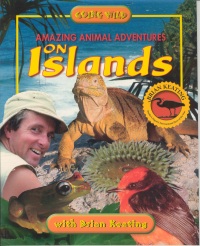| ________________
CM . . .
. Volume XIII Number 11 . . . .January 19, 2007 
 |
Amazing Animal Adventures on Islands. (Going Wild).
Brian Keating.
Calgary, AB: Fifth House, 2006.
48 pp., pbk. & cl., $12.95 (pbk.), $19.95 (cl.)
ISBN 1-894856-59-7 (pbk.), ISBN 1-894856-58-9 (cl.)
Subject Heading:
Island animals-Juvenile literature.
Grades 4-8 / Ages 9-13.
Review by Gillian Richardson.
*** /4
|
| |
|

excerpt:
Madagascar was formed when it was ripped away from the continent of Africa by plate tectonic action. Then, about 40 million years ago, a large raft of vegetation - probably made from roots and mats of soil torn from a riverbank during a storm - floated to the island from mainland Africa. Against all odds, this raft contained a cargo of lemurs, which would evolve on the isolated island in unimaginable ways.
What is so incredible about the life raft is that it must have carried enough of the lemurs to create a healthy population. Most of the animals that drifted or landed on the Galapagos Islands, for instance, were doomed because they came without mates to have babies. So when enough of a population makes a strange voyage like this, it's quite an accomplishment indeed!
The format for this series by the Director of Conservation Outreach at the Calgary Zoo is now well established: each of 10 chapters includes an engaging personal account of Keating's adventures, fact boxes and notes, definitions for challenging vocabulary, high quality photographs. In this fifth of eight titles, the focus is islands of the world, "exotic and exciting...also places of refuge." Keating ably entertains the reader with details of visits to such major islands as the Galapagos, Hawaii, Haida Gwaii (Queen Charlottes), New Zealand, Madagascar, Papua New Guinea and Borneo, as well as Lake Malawi (East Africa), described as "an 'island' of water surrounded by people and agriculture." The author's particular interest is the endemic species found in these 'isolated' environments. The finches and tortoises of the Galapagos became legendary through Darwin's writings. The honeycreeper has undergone similar evolution in the Hawaiian island of Kauai as have the lemurs of Madagascar. Haida Gwaii is home to the rare ancient murrelets. The attraction of Lake Malawi is the unusual chiclid fish whose youngsters take shelter inside the mother's mouth.
This husband and wife team's outstanding skills in photography are a key feature of the series. Close-ups and action shots are the norm to show the excitement and drama of their discoveries. The books are well designed to highlight the visual material, and in general, photos are well matched to the text. In this title, however, my curiosity was piqued by the specific references to two species of birds for which no photo was included: the honeycreeper (After hiking "for a day through mud up to our knees....we came across a few species [of honeycreepers]"), and hornbill ("we saw all 7 species of hornbill.") Perhaps no author photo was available for these birds.
Since the second book in the series, young readers have been encouraged to try hands-on activities related to nature study. As with the previous ideas, "Creating Your Own Natural History Museum" uses inexpensive materials, most likely to be found at home (although not everyone has a television or large appliance-sized box handy). The directions for making the museum, however, are not all that precise: "cut the large cardboard box so that it folds out and can be set on a table." And while the suggestion is to find objects "in your own backyard," readers are urged to collect things (non-living nor in use by living things) from "a nearby river......a stand of trees where an owl family is living...." This kind of interactive approach can increase the book's appeal as long as all aspects of it are readily accessible to youngsters.
The comprehensive listing of conservation organizations to contact for more information is a worthwhile addition to these books. Readers inspired by the fascinating glimpses of the natural world that Keating has shared will have no trouble learning more ... or finding that elusive honeycreeper or hornbill photo.
Highly Recommended.
A freelance writer and former teacher-librarian, Gillian Richardson lives in BC.

To comment
on this title or this review, send mail to cm@umanitoba.ca.
Copyright © the Manitoba Library Association. Reproduction for personal
use is permitted only if this copyright notice is maintained. Any
other reproduction is prohibited without permission.
NEXT REVIEW |
TABLE OF CONTENTS FOR THIS ISSUE
- January 19, 2007.
AUTHORS |
TITLES |
MEDIA REVIEWS |
PROFILES |
BACK ISSUES |
SEARCH |
CMARCHIVE |
HOME |
